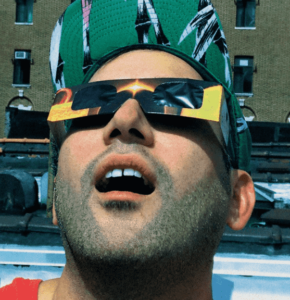Sufjan Stevens, a remarkable musical artist, boasts an impressive discography with nine studio albums to his name, each showcasing his unique creativity
Additionally, he has collaborated with various musicians, contributing to a plethora of albums. Stevens’ talent has not gone unnoticed, earning him nominations for prestigious awards such as the Grammy and Academy Awards.
Sufjan Stevens’ journey in the realm of music is a testament to his dedication, talent, and artistic prowess. With an array of albums and accolades to his name, he continues to captivate audiences with his exceptional musical abilities and creativity.
Sufjan Stevens’ sexuality is a multifaceted aspect of his identity, intricately woven into the fabric of his music and his being.
Rather than seeking a definitive label, let us embrace the beauty of individuality and the richness of artistic expression that Sufjan Stevens brings to the world.

Also Read: Is Eli Weaver Dead Or Alive? Obituary And Death News Explored
Table of Contents
Sufjan Stevens: Who Is He?
In a collaboration with his stepfather, Sufjan Stevens co-founded the Asthmatic Kitty record label, a pivotal moment that paved the way for his musical career.1
The label became the platform for his debut album, “A Sun Came,” released in 2000, marking the beginning of his musical journey.
The Breakout Moment: “Chicago” and the Illinois Album
Sufjan Stevens achieved widespread acclaim with his 2005 album, “Illinois,” especially the hit single “Chicago,” which soared to number one on the Billboard Top Heatseekers chart.
This accomplishment catapulted him into the limelight, solidifying his position as a significant musical artist.
Musical Contributions to “Call Me by Your Name” Soundtrack
In 2017, Sufjan Stevens made notable contributions to the “Call Me by Your Name” soundtrack, showcasing his versatility and talent.
One of the soundtrack’s standout tracks, “Mystery of Love,” earned him nominations for an Academy Award for Best Original Song and a Grammy for Best Song Written for Visual Media.

Sufjan Stevens: Sexuality and Gender Identity
Sufjan Stevens, an artist whose music evokes both emotion and curiosity, has been a subject of speculation regarding his sexuality.2
Is Sufjan Stevens gay, or is there more to the narrative? Delving into his lyrics and life, we aim to shed light on the complexity of his sexuality and challenge the notion of a strict sexual binary.

A Spectrum of Sexuality: Is Sufjan Stevens Gay, Straight, or Bisexual?
Sufjan Stevens’ sexuality is a nuanced and intricate aspect of his identity. While the question “Is Sufjan Stevens gay?” often arises, the answer isn’t confined to a simple yes or no.
Based on the themes depicted in his songs, it’s plausible that he identifies as bisexual. However, reducing his identity to a single label oversimplifies a much broader and more personal aspect of his life.
The Unique Expression of Sexuality
Sufjan Stevens’ approach to his sexuality is individualistic and distinct. He doesn’t feel the need to categorically define himself in the public domain. Instead, his music serves as a testament to his true essence.
Unlike artists who feel the urge to openly declare their heterosexuality, Sufjan embraces a more private stance, allowing his music to convey the depth of his identity.
The new album “Javelin” is out today!!!
— Sufjan Stevens (@sufjanstevens) October 6, 2023
Breaking Free from Binary Perceptions
Understanding Sufjan Stevens’ sexuality requires breaking free from binary perspectives of gay or straight.
Sexuality is a spectrum, and the extent of its expression varies from person to person. For Sufjan, it’s an individual journey, one that can’t be confined within rigid definitions.
Sufjan Stevens incorporates spirituality into his music, particularly focusing on Christianity. Tracks like “To Be Alone With You” from the album “Seven Swans” showcase his exploration of faith and its significance in his life.
However, being a Christian does not dictate one’s sexuality; it’s a separate aspect of a person’s identity.
Sufjan’s lyrics are a canvas open to personal interpretation. He himself acknowledges how interpretations can diverge from the intended meaning, illustrating the malleability of art.
Each song is a unique experience for the listener, and Sufjan masterfully incorporates the “pronoun game,” allowing his audience to engage and immerse themselves in his music.

Sufjan Stevens: Bio
Unveiling the Early Life Journey of Sufjan Stevens
Sufjan Stevens, a prominent musical genius of our era, emerged into the world in the bustling city of Detroit, Michigan.3
The vibrant streets of Detroit witnessed his first cries and initial steps. However, this urban backdrop was not where his tale truly began.
At the tender age of nine, Sufjan’s family undertook a significant change, uprooting from the urban sprawl and settling in the serene embrace of Alanson, Michigan. Nestled in the northern expanse of the Lower Peninsula of Michigan, this move brought about a shift in his life that would influence his musical journey.
A Patchwork Family and Diverse Heritage
Sufjan was raised under the care of his father, Rasjid, and stepmother, Pat. However, his connection with his mother, Carrie, remained a part of his life, albeit with infrequent visits, especially after her marriage to Lowell Brams, her second husband. This amalgamation of family dynamics shaped his character and artistic inclinations.
Sufjan’s educational voyage commenced at the Detroit Waldorf School, followed by stints at Alanson Public Schools and the Interlochen Arts Academy. He eventually graduated from Harbor Light Christian School, a significant milestone in his early life.
Sufjan’s academic prowess and dedication earned him entry into Hope College in Holland, Michigan, where he graduated with honors, being inducted into the esteemed Phi Beta Kappa society. The pursuit of knowledge didn’t end there; it propelled him to The New School in New York City to pursue a Master of Fine Arts (MFA).

The Symphony of Talents: From Oboes to Guitars
Musical inclinations were evident in Sufjan from an early age, as he melodiously played the oboe and English horn during his school years.
These instruments soon found their way into his musical compositions, gracing his CDs with their soulful tunes.
Upon his arrival at Hope College, a new passion ignited within him—the desire to master the guitar, an instrument that would become synonymous with his musical style and define his artistic trajectory.
The moniker ‘Sufjan’ carries with it a rich history and cultural significance. It finds its origins in the word ‘Sufi,’ meaning one who comes with a sword. This name, made famous by historical figure Abu Sufyan in the annals of early Islam, weaves a thread of heritage and identity into Sufjan Stevens’ persona.
A Spiritual Legacy: The Subud Connection
Sufjan Stevens’ name has roots in a spiritual heritage, deeply embedded in the foundation of Subud—an interfaith spiritual organization.
During the time of his birth, his parents were devout members of this community, and it was within the embrace of this faith that his name was bestowed upon him.
The early life of Sufjan Stevens lays a foundation of musical mastery, cultural tapestry, and spiritual connections that have continued to shape his remarkable journey as a musician and an artist.
These formative years have left an indelible mark on his work, offering listeners a glimpse into the depths of his soul through his melodies and lyrics.

Sufjan Stevens: Career
A Musical Journey Across the States
- Sufjan Stevens embarked on his musical journey as a member of Marzuki, a folk-rock band hailing from Holland, Michigan. He was also part of the garage band Con Los Dudes.
- Alongside, he showcased his multi-instrumental talents with Danielson Famile. During his final semester at Hope College, Stevens ventured into a solo career and recorded his debut album, “A Sun Came,” which was released through Asthmatic Kitty Records.
- His passion for music and storytelling led him to New York City, where he joined a writing program at The New School for Social Research. This period marked his deepening interest in short stories, which initially led him to believe he would write a novel but ultimately guided him back to songwriting.
- In New York, Stevens composed and recorded the music for his second album, “Enjoy Your Rabbit,” a unique song cycle based on the Chinese zodiac’s animals, delving into the realm of electronica.
- Following this, Stevens released “Michigan,” an album comprising folk songs and instrumentals. The songs were an ode to cities like Detroit and Flint, Michigan’s Upper Peninsula, and various vacation spots.
- Interwoven within scenic descriptions and characters were Stevens’ expressions of faith, sorrow, love, and the rejuvenation of Michigan. He announced his ambitious “Fifty States Project,” intending to create an album for each of the 50 U.S. states, starting with Michigan.
- Subsequently, Stevens compiled previously recorded songs into a side project titled “Seven Swans,” released in March 2004. Despite his growing music career, Stevens continued his work in the children’s book division at Time Warner until after the “Seven Swans” tour.
The Avalanche of Creativity and Beyond (2006–2009)
In April 2006, Stevens excitedly announced “The Avalanche,” incorporating 21 pieces of music from the “Illinois” recording sessions.
This album was released on July 11, 2006. He further expanded his musical repertoire, captivating audiences with “Majesty Snowbird,” a ten-minute-plus composition premiered in Nashville, Tennessee, on September 11, 2006.
Not limiting himself to the musical realm, Stevens gifted the world “Songs for Christmas” on November 21, 2006.
This five-CD box set contained originals and Christmas standards recorded annually since 2001 (excluding 2004).
Stevens began this project as a personal exercise to rekindle his appreciation for Christmas. The songs were a collaborative effort, involving various musicians and friends.
View this post on Instagram
Musical Collaborations and Diverse Contributions (2007–2009)
In the following years, Stevens engaged in numerous collaborative projects, showcasing his versatility and passion for music.
He worked with artists like Rosie Thomas, Denison Witmer, The National, and many more, contributing instrumentally and vocally to various albums.
Stevens also ventured into covers, infusing his unique interpretation into songs by renowned artists such as Joni Mitchell, Bob Dylan, and Prince. His music found its way into movies, enhancing the emotional tapestry of films like “Driving Lessons.”
Beyond his musical pursuits, Stevens showcased his writing prowess, contributing essays and stories to publications like Asthmatic Kitty Records’ “Sidebar” feature and Topic Magazine. He also initiated the “Xmas Song Exchange Contest” and hosted private listening parties to share exclusive music with dedicated fans.
Throughout his career, Stevens demonstrated a remarkable ability to evolve and diversify his contributions to the music industry, captivating audiences and leaving an indelible mark on the landscape of contemporary music.
Also Read: Who Are D. J. Moore: Parents? Bio, Career, Siblings, Family, Net Worth 2023 and More




